The imposition of kinesiology tape on the calf area
Popliteal muscle
Achilles tendon and triceps muscle of calf
Gastrocnemius muscles and Achilles tendon
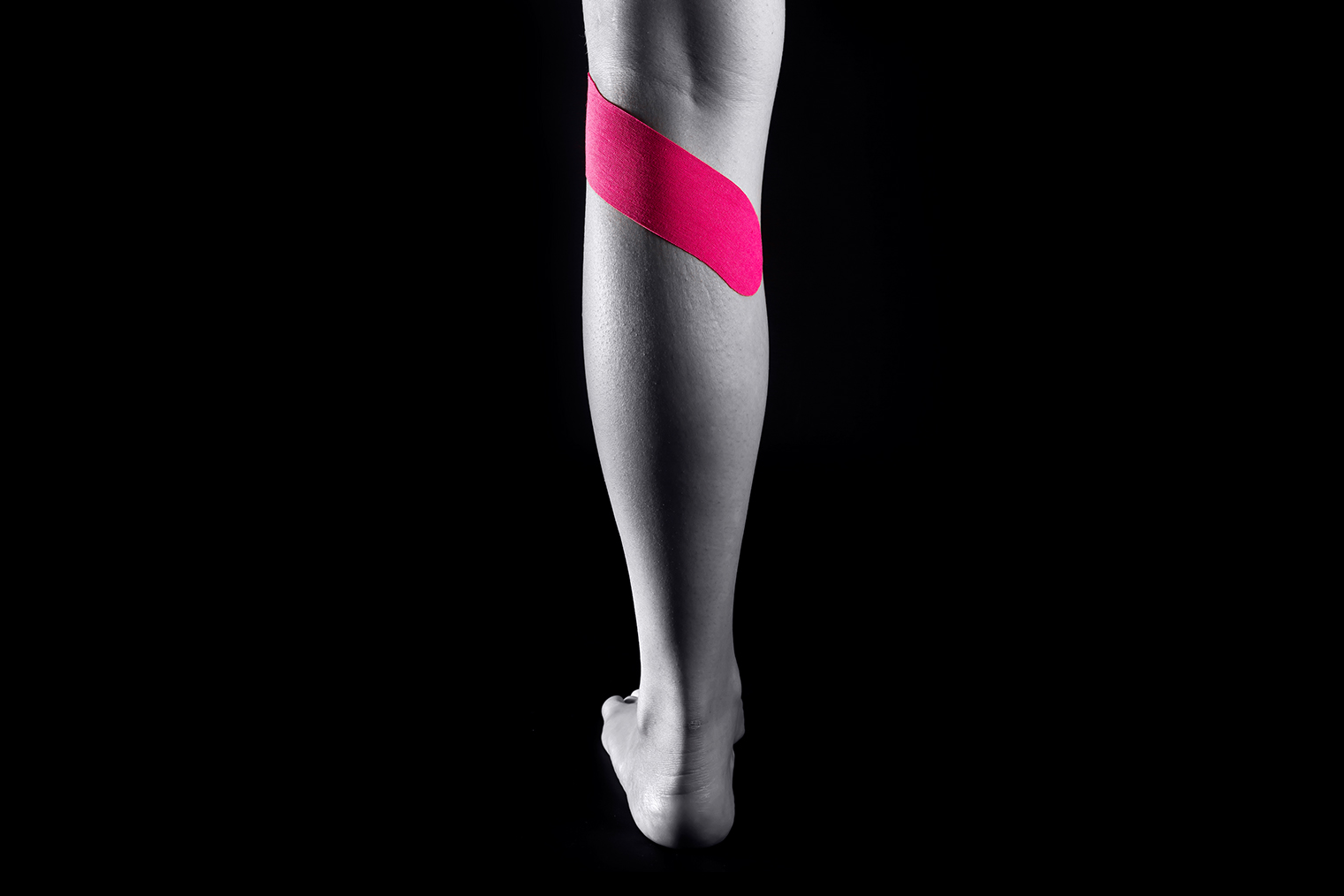
Indications: Hypertonic popliteal muscle, trigger points
1. This method requires one I-tape of 10-15 cm long, depending on anatomic features of the patient.
2. It should be noted that the tape should be applied on a maximally stretched muscle.
3. Apply the base of the tape on the site of muscle insertion to the posterior surface of tibia. Then apply an operating part of the tape with a 15 % tension towards lateral condyle of femur.
Achilles tendon and triceps muscle of calf
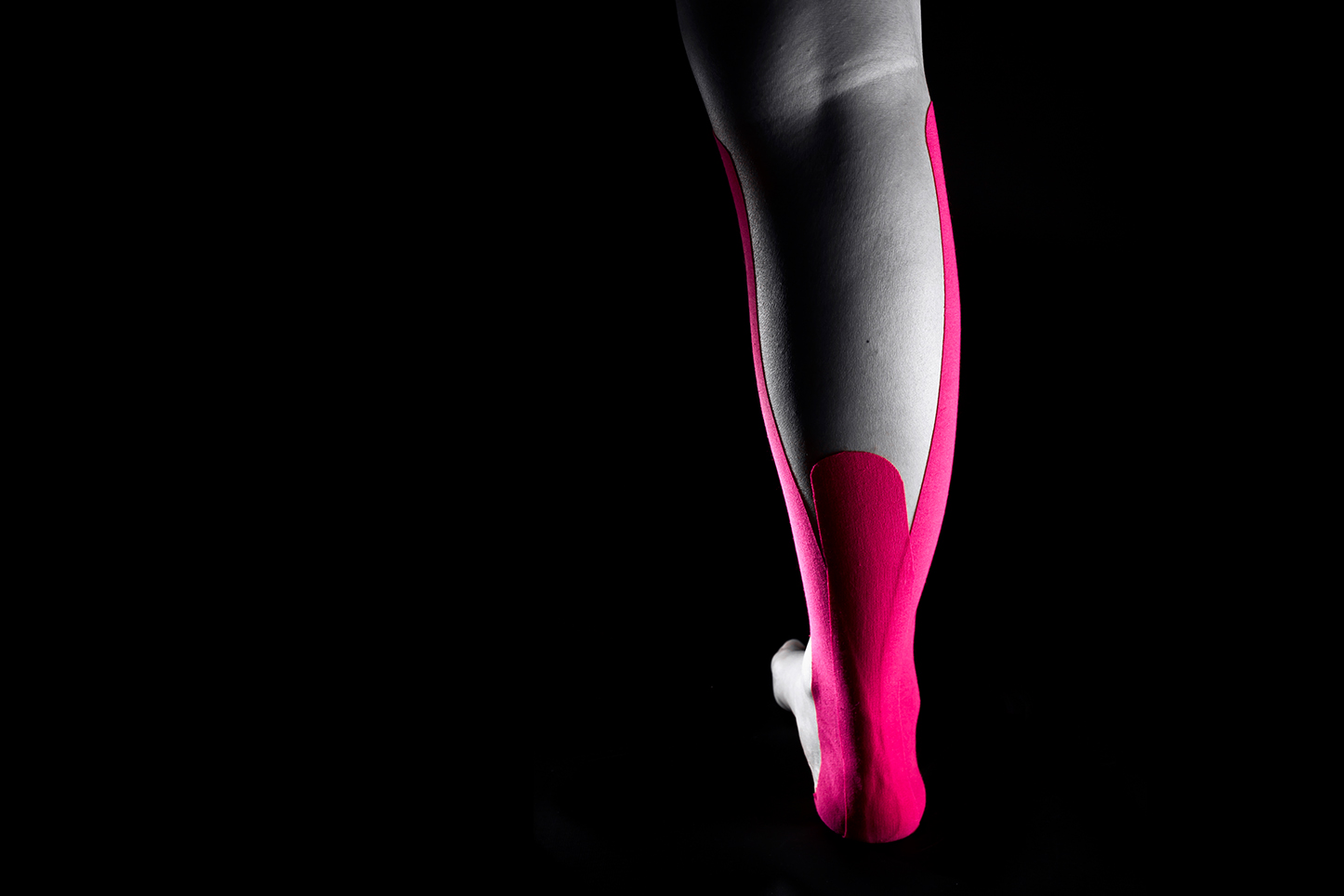
Indications: Hypertonic triceps muscle, injury of Achilles tendon, trigger points
1. This method requires one I-tape approximately 20 cm long and one Y-tape of bout 40 cm long. Ratio of the lengths of lobes of Y-tape is about 1:4.
2. First of all, apply Y-tape. The base of Y-tape is applied on the heel region. Then apply long lobes of the tape along the anatomic shape of the triceps muscle with a 15 % tension.
3. Then apply I-tape. Apply the base of the tape on heel region without tension.
4. Then apply the tape towards Achilles tendon with a maximal tension. Apply anchor without tension.
Gastrocnemius muscles and Achilles tendon
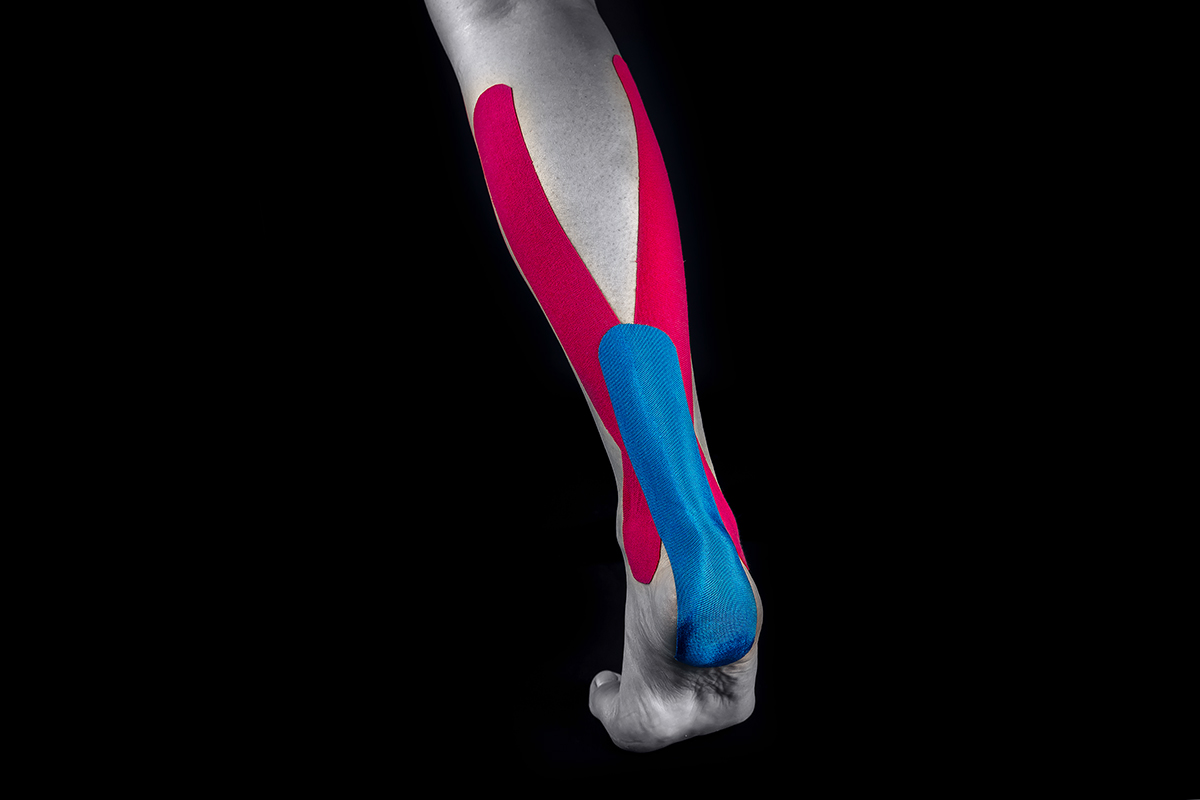
Indications: Injury of Achilles tendon, hypertonic muscle, trigger points, rehabilitation in the post-operation period after suturing on Achilles tendon
1. This method requires three I-tapes approximately 20–25 cm long.
2. Apply the base of the first tape on the heel region without tension.
3. Ask the patient for dorsiflexion (pull the toes towards himself/herself) and apply the tape with the maximal tension towards Achilles tendon.
4. Then, apply the tape with a 15 % tension from the lateral malleolus to the medial head of the gastrocnemius muscle.
5. Perform the same actions on the opposite side. Apply the tape with a 15 % tension from medial malleolus in a diagonal direction through a middle third of the calf and to the lateral head of gastrocnemius muscle.
Medial tibial stress syndrome
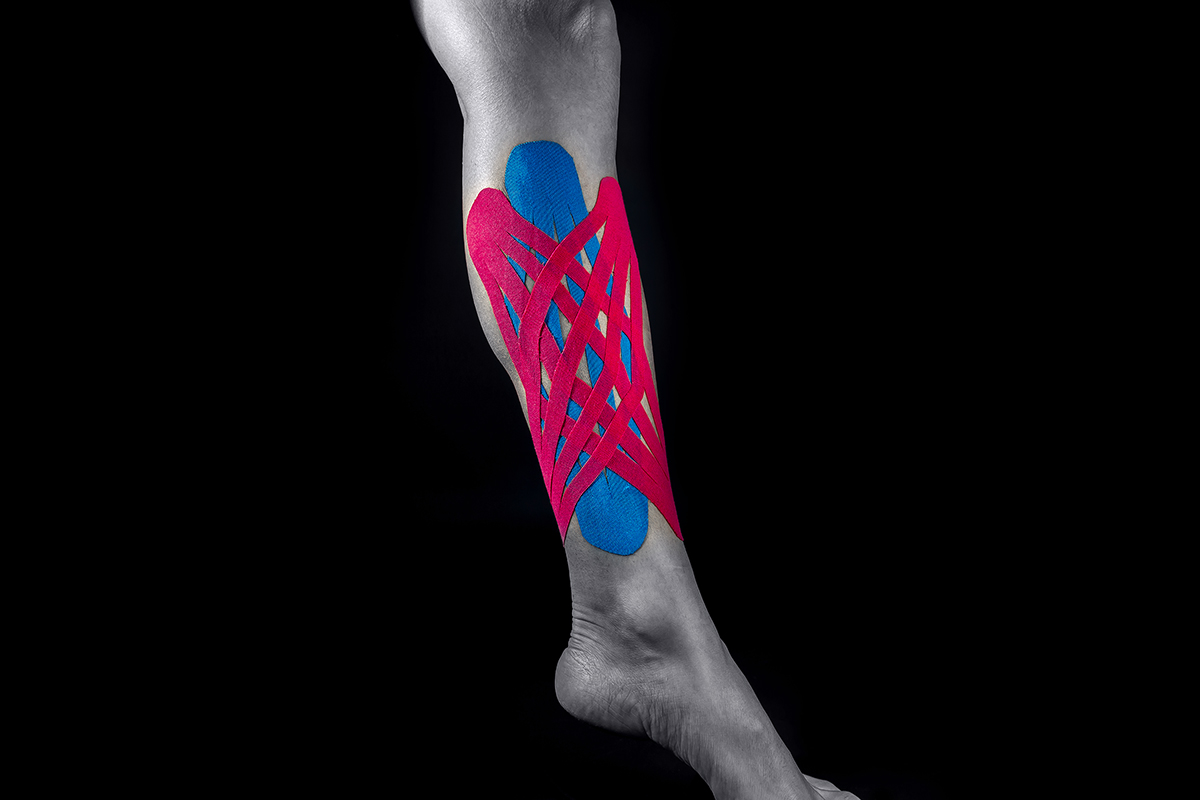
Indications: inflammation of periosteum, periostitis
1. In this case, we need 3 pieces of the tape 20 cm long.
2. After rounding of the ends, double up the tape and cut it by strips. The ends (about 4 cm on each side) are left integer.
3. Apply the first tape by fascia method directly to the zone of maximal pain syndrome.
4. Apply the second and the third tape crosswise with crossing points in the zone of maximal pain syndrome.
Tendinitis of Achilles tendon
Tendinitis of Achilles tendon
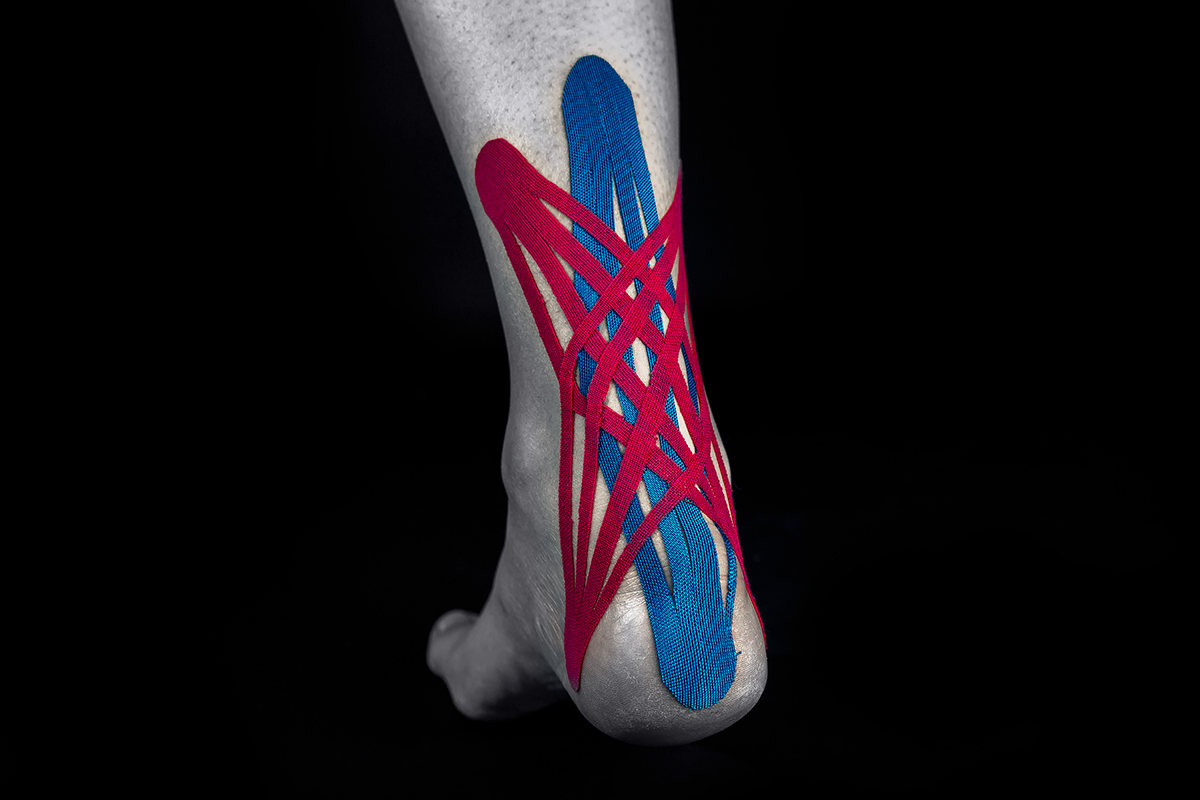
Indications: Tendinitis of Achilles tendon, rehabilitation after injury of Achilles tendon
1. This application requires 3 fascia tapes approximately 10 cm long and 2.5 cm large.
2. Apply the first tape by fascia method directly to the zone of Achilles tendon.
3. Apply the second and the third tape crosswise with crossing points in the zone of maximal pain syndrome.
Tibialis posterior muscle
Tibialis posterior muscle
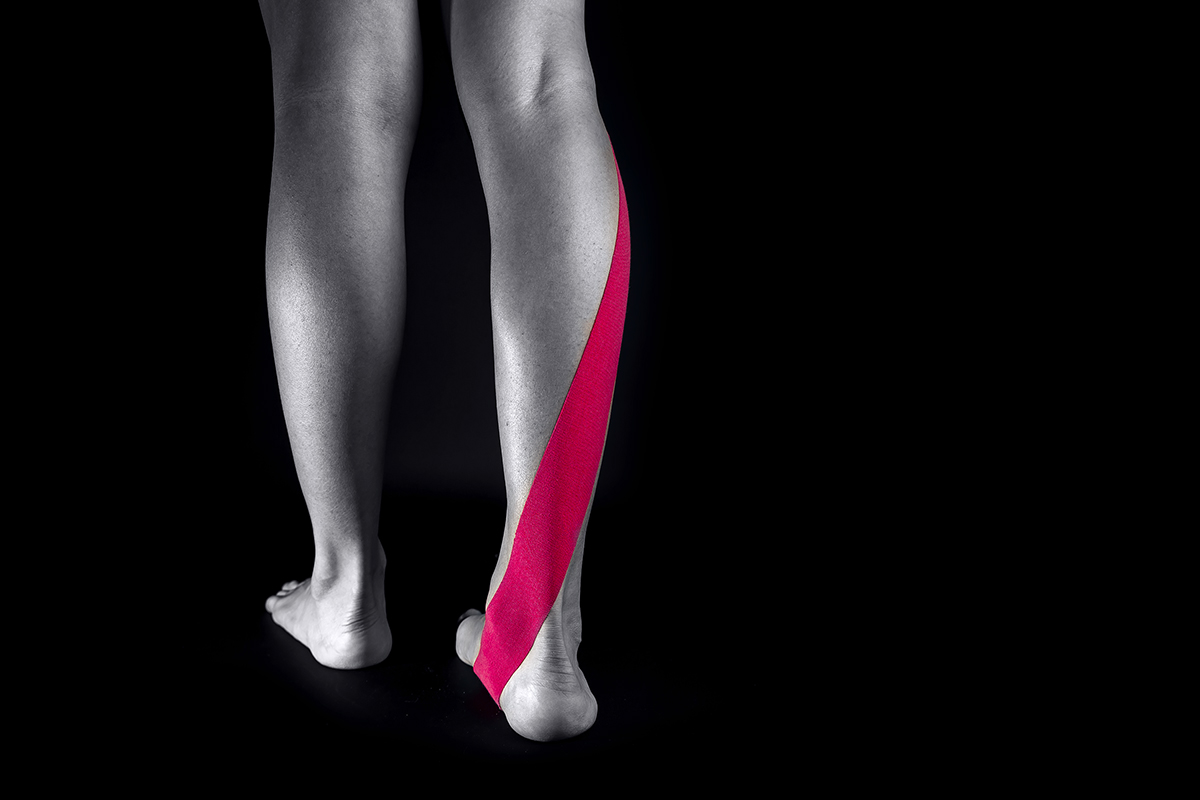
Indications: flat foot, medial tibial stress syndrome, arthrosis of ankle joint
1. This method requires one I-tape approximately 30 cm long. The length of the piece directly depends on the patient’s anatomic features.
2. Apply the base of the tape in the region of longitudinal arch of the foot.
3. Ask the patient for bending in the ankle joint.
4. Then apply a tape with 15 % tension according to the anatomy of posterior tibial muscle towards proximal interosseal membrane of tibia and fibula.
5. Apply a tape anchor without tension.
Damage of gastrocnemius medial head
Damage of gastrocnemius medial head
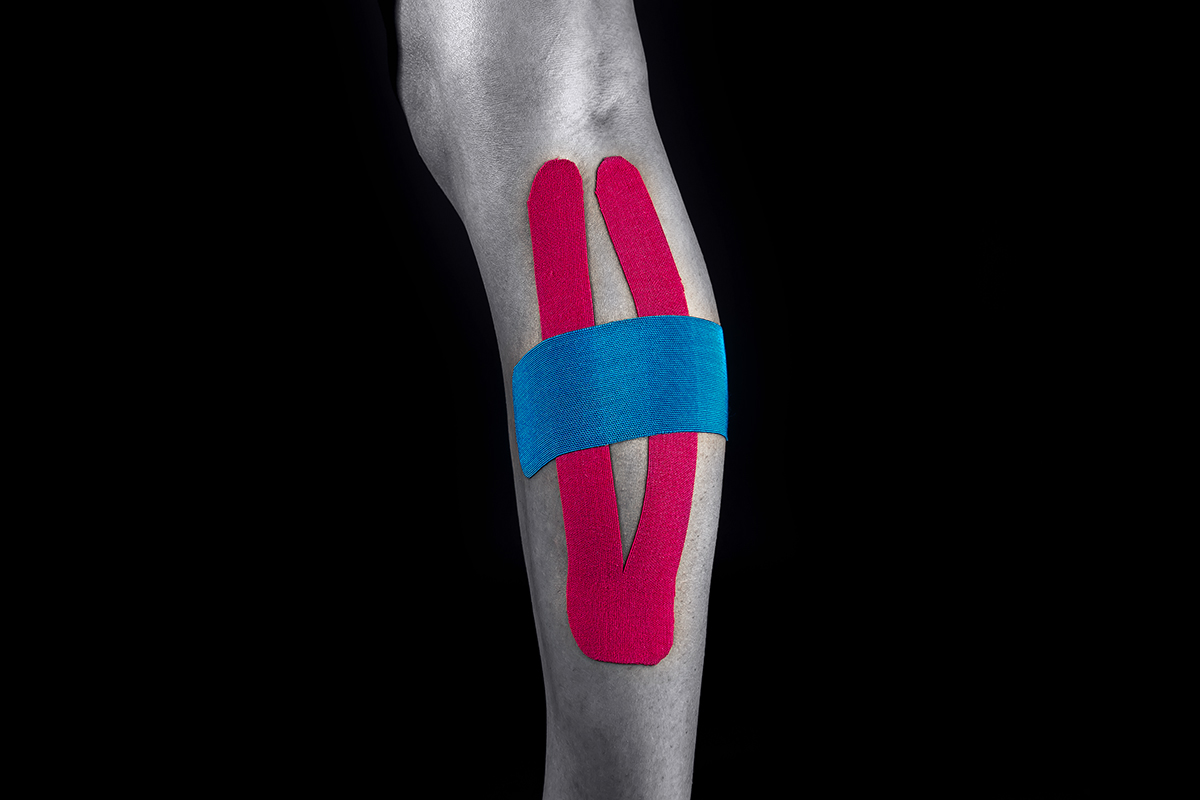
Indications: Damage of gastrocnemius medial head, hypertonic muscle, trigger points
1. This method requires one Y-tape approximately 12–15 cm long, as well as one I-tape approximately 10 cm long.
2. Apply the base of the tape on the middle of calf from the medial side without tension. Apply strips of the tape in parallel to each other on medial head of the muscle towards popliteal fold with a 15 % tension.
3. Apply the second tape perpendicularly to Y-tape in the region of concern using ligament method.
Achilles tendon
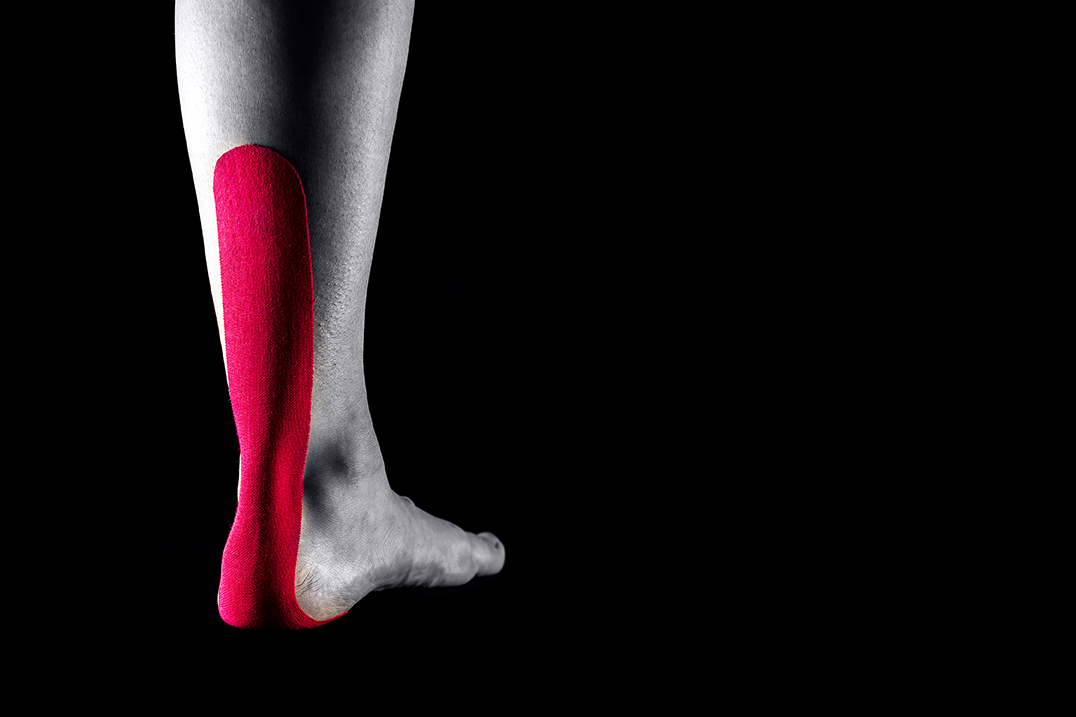
Indications: Injury of Achilles tendon
1. This method requires one I-tape approximately 20 cm long.
2. Apply the base of the tape on heel region without tension.
3. Ask the patient for dorsiflexion (pull the anklet towards himself/herself)
4. Then apply the tape towards Achilles tendon with a maximal tension.
5. Apply a tape anchor without tension.
Tibialis Anterior Muscle
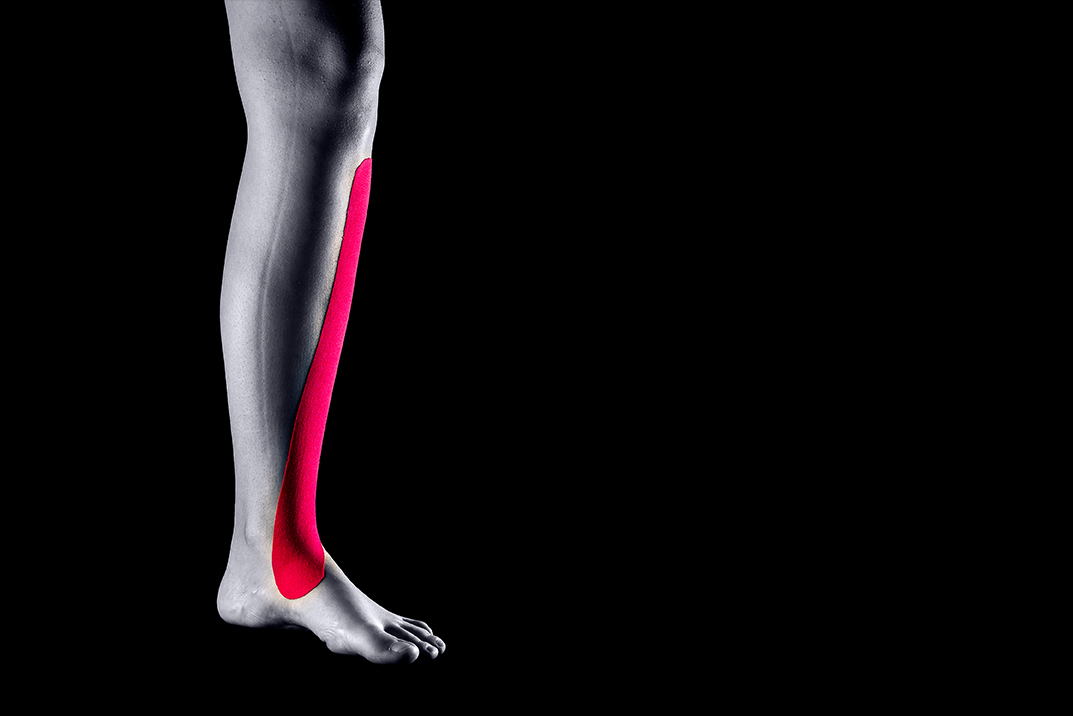
Indications: Flat foot, instability of the ankle joint
1. This method requires one I-tape approximately 30 cm long. The length of the piece directly depends on the patient’s anatomic features.
2. Apply the base of the tape on the point of muscular insertion — medial sphenoid bone and the base of first metatarsal bone.
3. Ask the patient for extension in the ankle joint.
4. Then apply the tape with a 15 % tension according to the anatomy of anterior tibial muscle to the place of start — lateral malleolus of tibia. Apply a tape anchor without tension.
Shin splints
Shin splints
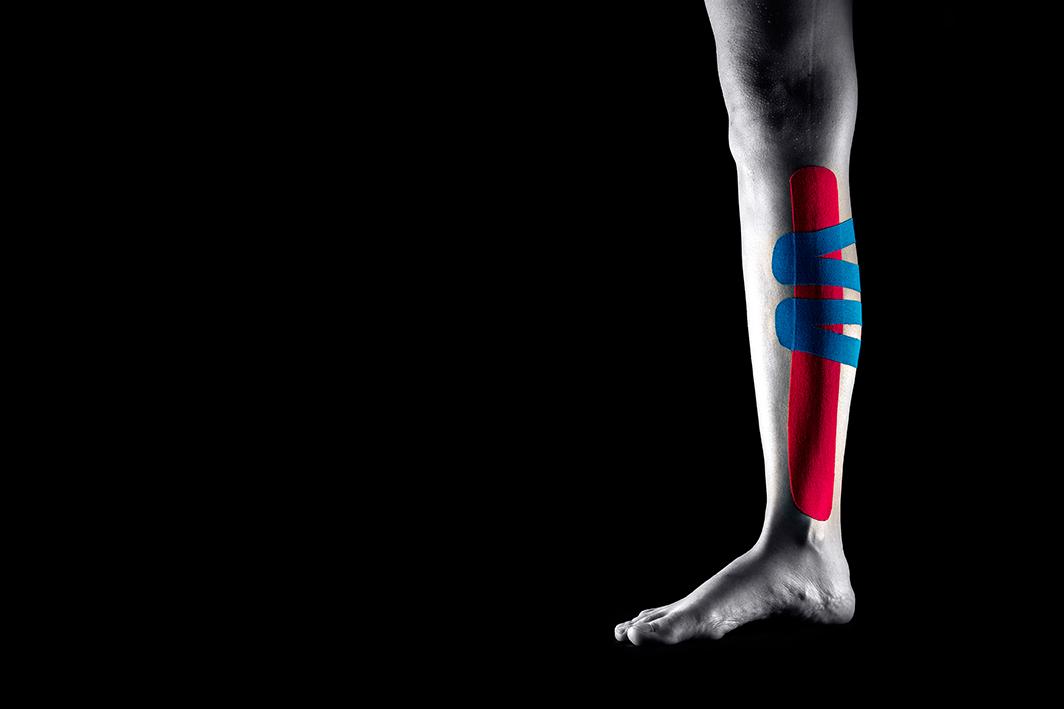
Indications: aching pain along the anterior calf surface, Medial tibial stress syndrome
1. This application requires one I-tape 25 cm long and two Y-tapes 10 cm long.
2. First of all, apply I-tape. The base is applied slightly over medial malleolus.
3. Then apply the tape with a minimal tension on the boundary of tibia and soleus/posterior tibial muscle.
4. Apply anchor without tension.
5. Apply the bases of the second and third Y-tape in the projection of the anterior margin of tibia, in the region of pain, and lobes of the tape are applied with a 15 % tension on the posterior calf surface, covering gastrocnemius medial head.
Swelling in the region Triceps Surae muscle
Swelling in the region Triceps Surae muscle
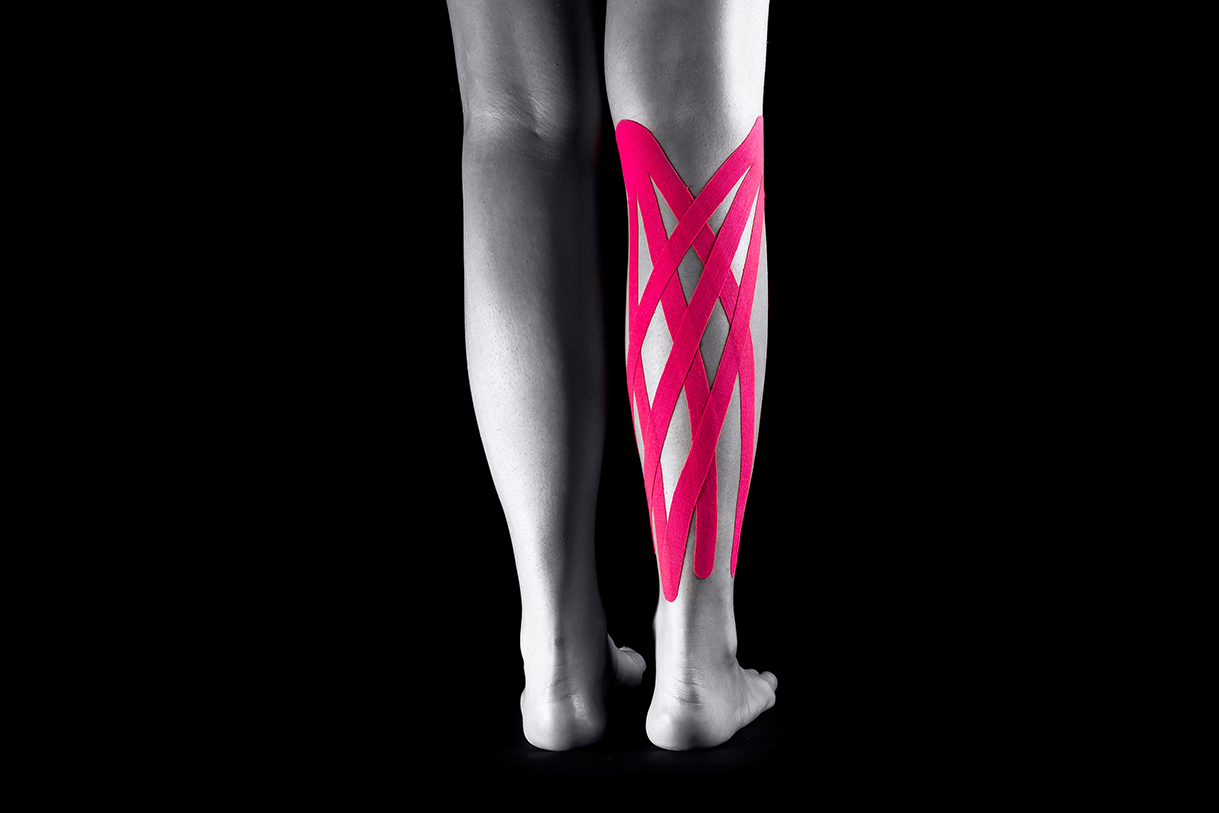
Indications: acute injury of triceps muscle of the calf, soft tissue bruise, swelling of the calf
1. Cut off two tapes approximately 25 cm long. Cut the tape into 4-5 long strips. The tape base is 4 cm, and it is left integer. The width of cut tape strips should be 0.7 cm to 1.5 cm.
2. Apply the base of the tape without tension towards the nearest lymph node on the dorsal site. In this case, these are popliteal lymph nodes.
3. Apply the strips with a minimal tension on the skin, completely covering the swelling zone.
Triceps Surae muscle
Triceps Surae muscle
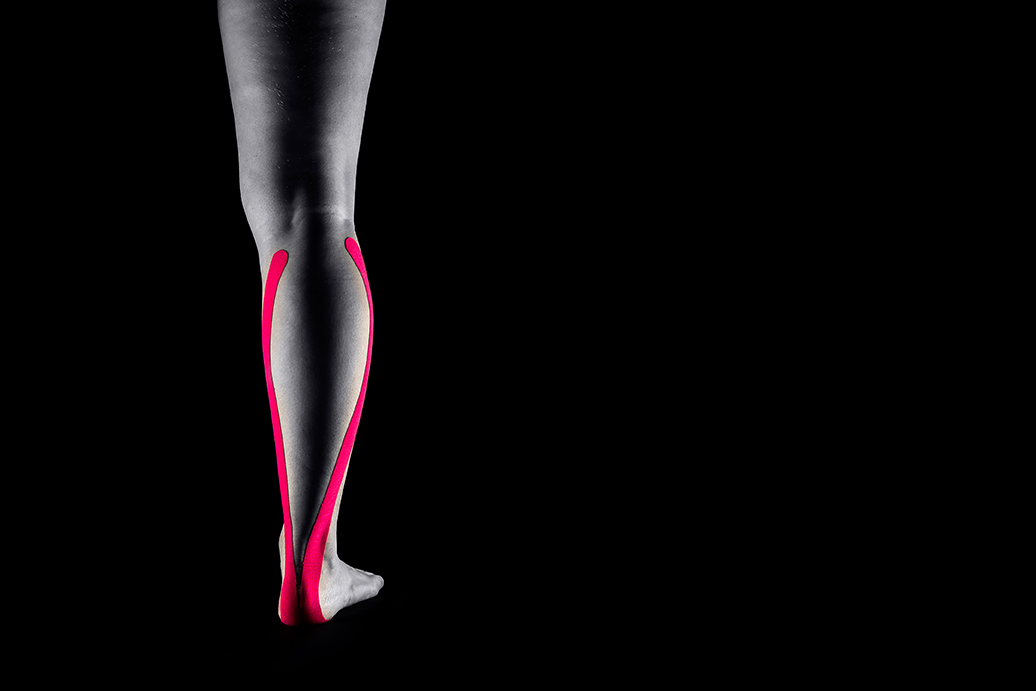
Indications: Hypertonic triceps, trigger points
1. This method requires one Y-tape approximately 40 cm long. The ratio of lobe lengths of Y-tape is about 1:4.
2. Apply the base of Y-tape on heel region without tension.
3. Then apply long lobes of the tape along the anatomic shape of the triceps muscle with a 15 % tension.
4. Apply a tape anchor without tension.
Install NOW "Medical Taping" Mobile App On Android or iOS!
March 2020
April 2020
May 2020
 Shopping cart (0)
Shopping cart (0)
